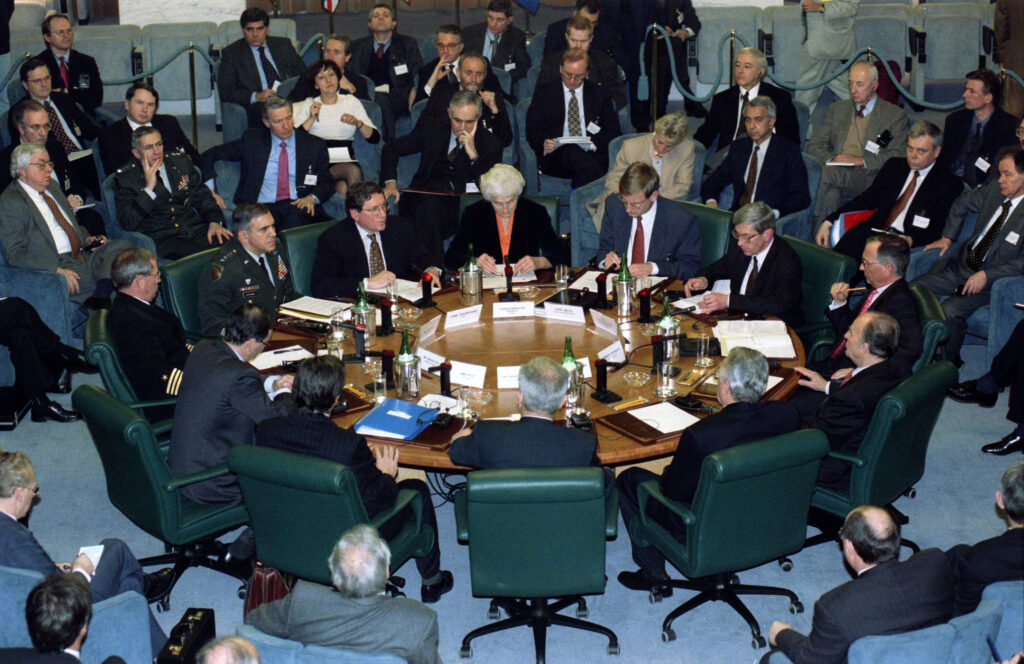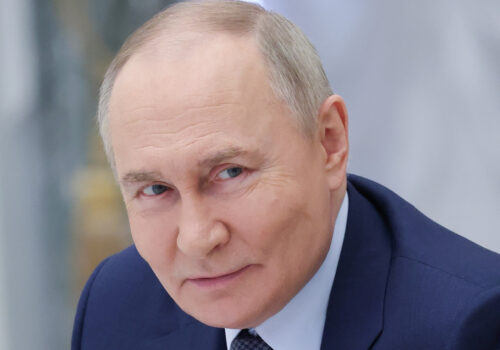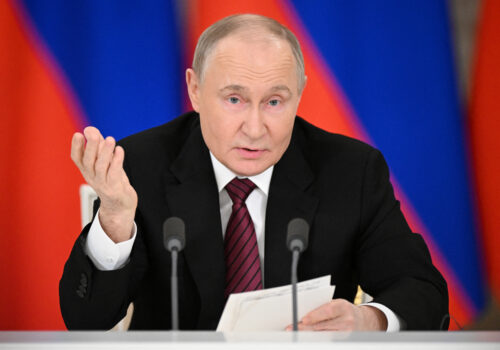DAYTON, Ohio—US President Donald Trump could learn a lot about how to best end Russia’s murderous war on Ukraine, now into its fourth year, from the US experience here thirty years ago in negotiating what became known as the Dayton Peace Accords.
If Trump wants to stop Russian President Vladimir Putin’s war, and he has made that an administration priority, then he should reflect on what it took to finally stop Serbian President Slobodan Milošević in 1995—after nearly four years of killing and more than 100,000 dead, including the massacre at Srebrenica, Europe’s worst genocide since the Holocaust.
A deal required relentless US diplomatic engagement backed by a demonstrated military threat and carried out alongside unified European allies. It also took twenty-one days of intensive negotiations in Dayton—not involving then US President Bill Clinton until the end—while all parties were cloistered from media and outside influences at Wright-Patterson Air Force Base.
Marking the Dayton anniversary, Ohio Congressman Mike Turner brought the NATO Parliamentary Assembly here last week, gathering delegates from the thirty-two allies as well as from partner countries. They joined leaders from the Western Balkans, assorted experts, and even the Sarajevo Philharmonic, which performed for participants in a giant hangar stocked with presidential aircraft in the National Museum of the US Air Force.
Though I came to commemorate history, I left having interrogated its architects. My aim was to gain clues that might help the Trump administration in its still-fruitless quest for an end to Russia’s war on Ukraine.
It would be easy to discount the lessons for Ukraine and Russia now, where the stakes are so much higher, from Bosnia-Herzegovina and Serbia then. Nuclear-armed Russia has two hundred times the land mass of Serbia and more than twenty times its population. And Ukraine, with its pre-war population of forty million and France-sized territory, is more than ten times larger in geographic size and population than Bosnia-Herzegovina. In my view, that makes the lessons only more compelling.
The first lesson? “Peace agreements are extremely rare,” former Swedish Prime Minister Carl Bildt, the European Union’s special representative at the talks thirty years ago, said in a session of former officials that I moderated. “In modern European history, there are only two really: Dayton and the Good Friday Agreement,” which in 1998 ended a thirty-year conflict in Northern Ireland known as “the Troubles.”
Both were forged in the aftermath of horrific violence, which is also the case in Ukraine. Yet both also required something that is still lacking today: determined, focused, and creative US leadership in lockstep with European partners. Both also succeeded through disciplined diplomacy, military leverage, and the unglamorous work of compromise.
Beyond that, winning peace in Dayton demanded US credibility but not neutrality. At Dayton, the United States was not an impartial mediator but rather a focused powerbroker, using whatever muscle was necessary to shape the outcome. No lasting deal can reward Putin’s aggression, just as Dayton didn’t knuckle under to reward Milošević.
Another lesson is that building peace is as crucial as ending war. Dayton and Belfast were both followed by years of international engagement, economic aid, and security commitments. Peace might have collapsed had those efforts not continued.
Most importantly, the United States led but did not go it alone. Peace that endures requires multilateral support. Dayton hasn’t worked perfectly, but without the European Union and NATO it wouldn’t have worked at all. “Only when the international actors can get together with a uniform message and policy can results be achieved,” said Bildt, who is also an Atlantic Council International Advisory Board member. “There was success in Dayton, yes. But it should also be said that there was massive failure prior to Dayton due to disagreements across the Atlantic, disagreements in Europe, and disagreements in the United States.”
US General Wesley Clark, who at the time was the military right hand to Richard Holbrooke, the chief US negotiator, took away a different lesson: “Don’t be timid,” Clark, a member of the Atlantic Council Board of Directors, said to the NATO parliamentarians. “We are going to have to be unified. And we are going to have to be forceful enough to convince Putin he will not win. Right now, he thinks he’s winning.”
In a slap across the face of Trump’s efforts to broker peace, Putin from last Friday to Sunday launched what Ukrainian officials called the largest combined aerial assault of the conflict, including some nine hundred drones and dozens of missiles of various types. That prompted a frustrated Trump to write on Truth Social about Putin that “something has happened to him. He has gone absolutely CRAZY!” The US president added that “missiles and drones are being shot into Cities in Ukraine, for no reason whatsoever.”
The problem is that there’s nothing crazy about Putin’s calculations, and his reasons are obvious. He’s trying to wear down Ukraine and its partners, and he’s betting that he has more staying power. He sees US military and diplomatic support in retreat, European efforts as insufficient, and Ukraine as weary. Trump has belatedly acknowledged that Putin has been “tapping” him along.
With all that in mind, Washington will have to try far harder now than it did then to change a murderous despot’s mind—or resign itself to accepting Putin’s ongoing war and its ambition to redraw the European map.
Until Washington stood up to Milošević in 1995, Clark said, the Serb leader thought he could pull the wool over Europe’s eyes with his small army overrunning Bosnia. When he bid farewell to Milošević at the end of the talks, Clark remembers the Balkan leader saying, “We Serbs never had a chance against your NATO, your airplanes, your missiles.”
Speaking with me at the same NATO session, Christopher R. Hill, who was part of the Holbrooke delegation in Dayton, added another important lesson—that the parties must be ready to end the war. “I am not sure Russia is ready for peace,” he said. “They should be, but they don’t seem to be. I think until they are, we have got to help Ukraine because a hundred years from now . . . our grandchildren, our great-grandchildren, will be thinking about what we did to deal with this crisis.”
The Dayton Accords were not perfect, but they were proof of what US leadership can achieve when properly applied. Speaking in Bosnia-Herzegovina shortly after the agreement was finalized, the then US president explained why the United States had chosen to lead, rather than cut and run from the European conflict.
“Around the world, people look to America not just because of our size and strength but because of what we stand for and what we’re willing to stand against,” Clinton said. “And though it imposes extra burdens on us, people trust us to help them share in the blessings of peace. We can’t be everywhere . . . But where we can make a difference, where our values and our interests are at stake, we must act.”
Frederick Kempe is president and chief executive officer of the Atlantic Council. You can follow him on X: @FredKempe.
This edition is part of Frederick Kempe’s Inflection Points newsletter, a column of dispatches from a world in transition. To receive this newsletter throughout the week, sign up here.
Further reading
Tue, May 27, 2025
Do Trump’s criticisms of Putin mark a turning point in his Russia policy?
New Atlanticist By John E. Herbst
On Sunday, the US president called his Russian counterpart “crazy” on social media, revealing an increasing impatience with Russia over its unwillingness to engage in US-led cease-fire talks.
Wed, May 21, 2025
Europe is striking back at Russia’s shadow fleet. Here’s what to know about the latest EU and UK sanctions.
New Atlanticist By
This week, Brussels and London unveiled new sanctions against Russia and the fleet of oil tankers and other vessels covertly trading in Russian oil. Atlantic Council experts assess the moves.
Tue, May 13, 2025
How much longer will Putin be allowed to continue stalling for time?
UkraineAlert By Peter Dickinson
President Trump has made a legitimate effort to broker a generous peace, but the time has now come to acknowledge that Putin is not negotiating in good faith and will only respond to the language of strength, writes Peter Dickinson.
Image: General view of the round table and meeting room where the presidents of Bosnia, Croatia and Serbia and western mediators met for an emergency summit to review the Dayton peace agreement February 17. The presidents began an emergency summit aimed at winning fresh commitments to the Dayton peace accord and cementing peace in Bosnia. REUTERS




